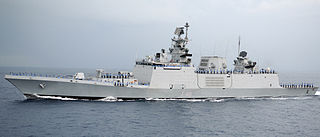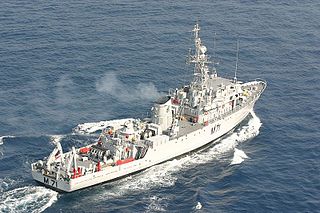
A carrier battle group (CVBG) is a naval fleet consisting of an aircraft carrier capital ship and its large number of escorts, together defining the group. The CV in CVBG is the United States Navy hull classification code for an aircraft carrier.

The Indian Navy (IN) is the maritime branch of the Indian Armed Forces. The President of India is the Supreme Commander of the Indian Navy. The Chief of Naval Staff, a four-star admiral, commands the navy. As a blue-water navy, it operates significantly in the Persian Gulf Region, the Horn of Africa, the Strait of Malacca, and routinely conducts anti-piracy operations and partners with other navies in the region. It also conducts routine two to three month-long deployments in the South and East China seas as well as the western Mediterranean sea simultaneously.

USS Crowninshield (DD–134) was a Wickes-class destroyer in the United States Navy between World War I and World War II. She was named for Benjamin Williams Crowninshield. In World War II she was transferred to the Royal Navy where she was named HMS Chelsea, and subsequently to the Soviet Navy where she was named Derzky.

The Rajput-class guided-missile destroyers built for the Indian Navy are modified versions of Soviet Kashin-class destroyers. They are also known as Kashin-II class. The ships were built in the former Soviet Union after considerable Indian design modifications to the Kashin design. These included the replacement of the helicopter pad in the original design with a flight elevator, as well as major changes to the electronics and combat systems. Five units were built for export to India in the 1980s. All units are currently attached to the Eastern Naval Command.

INS Rajput was a guided-missile destroyer and the lead ship of the Rajput class of the Indian Navy. It was commissioned on 4 May 1980. It was the first destroyer of the Indian Navy. It was built by the erstwhile USSR. Commodore Gulab Mohanlal Hiranandani was her first commanding officer.

INS Rana is a Rajput-class destroyer in active service with the Indian Navy. She was commissioned on 28 June 1982.

The Kashin class, Soviet designation Project 61, were series of anti-aircraft guided-missile destroyers built for the Soviet Navy since the 1960s. As of 2020, no ships remain in service with the Russian Navy, but three modified ships continue in service with the Indian Navy as Rajput-class destroyers.

INS Ranvir is the fourth of the five Rajput-class destroyers built for the Indian Navy. Ranvir was commissioned on 28 October 1986.

HMS Rotherham was an R-class destroyer of the British Royal Navy during the Second World War, named after Captain Edward Rotheram, who commanded HMS Royal Sovereign during at the Battle of Trafalgar in 1805. Rotherham was completed in 1942 and equipped as a flotilla leader, having slightly reduced armament to allow for the increased complement and working space required. Decommissioned in 1945, the ship was sold to India in 1948, serving as INS Rajput (D141) until 1976, when she was scrapped.

The Shivalik class or Project 17 class is a class of multi-role stealth frigates in service with the Indian Navy. They are the first stealth warships built in India. They were designed to have better stealth features and land-attack capabilities than the preceding Talwar-class frigates. A total of three ships were built between 2000 and 2010, and all three were in commission by 2012.

The Pondicherry class are a class of minesweepers built for the Indian Navy by the Soviet Union. They are modified versions of the Natya-class minesweeper. The vessels were acquired in two batches. The first were purchased from 1977 to 1980 and the second from 1986 to 1988. Technically, the second batch is referred to as the Karwar class but are physically identical to the first batch with the exception of additional surface-to-air missiles. As minesweepers, they are large and heavily armed. They can serve a dual purpose as an anti-submarine warfare escort. Their hulls are constructed of U3 low magnetic signature steel.

INS Shivalik (F47) is the lead ship of her class of stealth multi-role frigates built for the Indian Navy. She is the first stealth warship built by India. She was built at the Mazagon Dock Limited (MDL) located in Mumbai. Construction of the vessel began in 2001 and was completed by 2009. She underwent sea trials from thereon before being commissioned on 29 April 2010.

INS Kursura (S20) was a Kalvari-class diesel-electric submarine of the Indian Navy. It was India's fourth submarine. Kursura was commissioned on 18 December 1969 and was decommissioned on 27 February 2001 after 31 years of service. It participated in the Indo-Pakistani War of 1971, where it played a key role in patrol missions. It later participated in naval exercises with other nations and made many goodwill visits to other countries.

INS Kulish is a Kora-class corvette, currently in active service with the Indian Navy. She was ordered in October 1994 and the keel was laid in October 1995. The ship was launched in August 1997 and was commissioned on 20 August 2001.

INS Shakti (A57) (Strength) is a Deepak-class fleet tanker in service with the Indian Navy. She was built by Fincantieri, an Italian shipbuilding company based in Trieste. She is the second and final ship of her class. Shakti, along with her predecessor Deepak, the ship is one of the largest ships of the Indian Navy.

INS Jyoti (A58) is the third of the four Komandarm Fedko-class replenishment oilers. She was modified for naval use and is now being operated by the Eastern Naval Command of the Indian Navy. Jyoti was the largest ship in the navy until INS Vikramaditya (R33) was commissioned in November 2013. Its primary role is fleet replenishment and sustaining blue-water operations. It was later fitted with close-in weapon systems for self-defence.

Theatre Level Operational Readiness Exercise (TROPEX) is an inter-service military exercise involving the participation of the Indian Army, Air Force, Navy and the Coast Guard. The exercise generally commences at the beginning of each year and lasts a month. It is generally carried out in three phrases: independent workup phase, joint workup phase and tactical phase.
Vice Admiral Elenjikal Chandy Kuruvila, PVSM, AVSM was a former Flag officer in the Indian Navy. He was the Fleet commander of the Western Fleet during the Indo-Pakistani War of 1971, for which he was awarded the Param Vishisht Seva Medal. He later led the Southern Naval Area and then served as the Chairman and Managing Director of Mazagon Dock Limited.


















